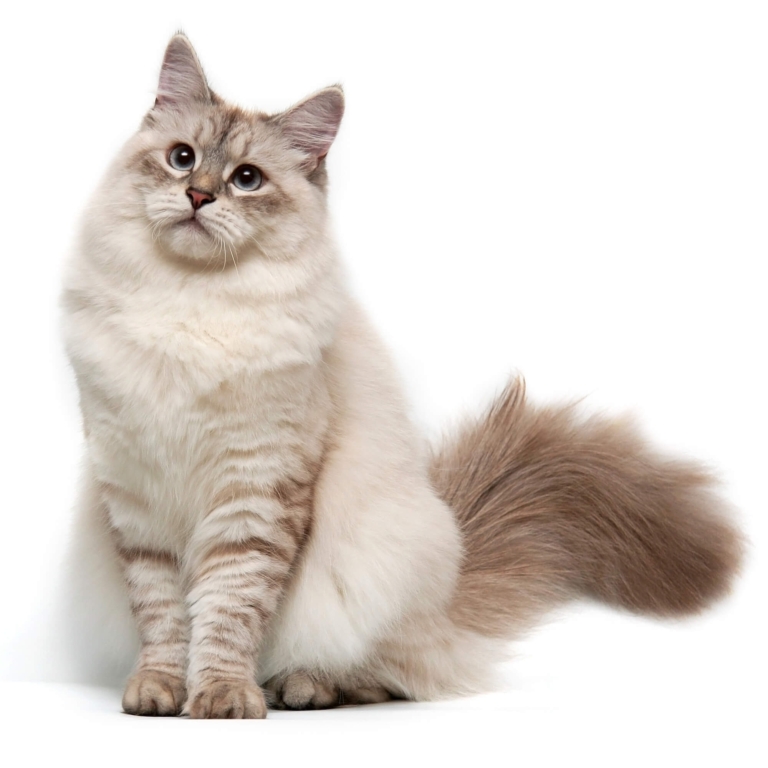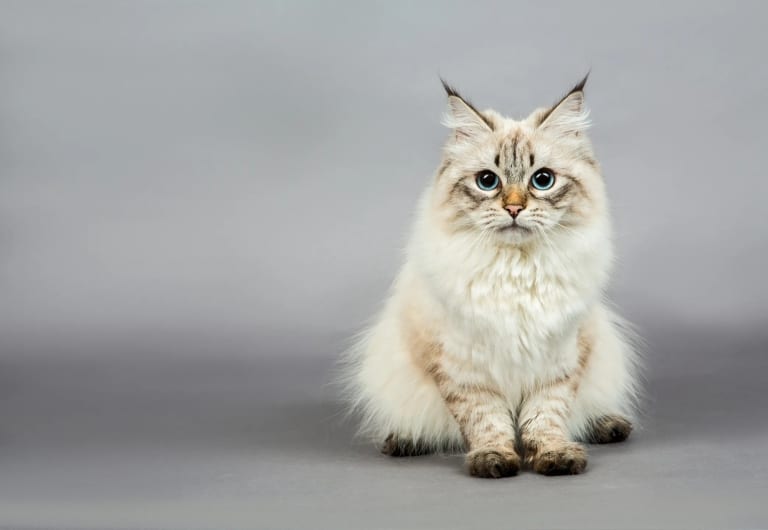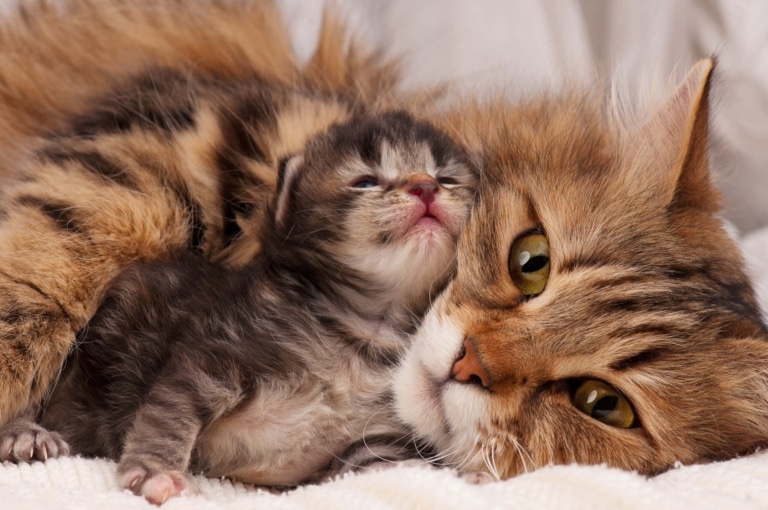




Siberian cat is a real embodiment of strength and tenderness in one body. These fluffy beauties impress with their appearance at first sight: strong muscular physique, massive paws with tassels of hair between the fingers, round face with an intelligent and deep look. Adult Siberian can weigh from 4 to 9 kg, and sometimes more – males are usually larger and wider. At the same time, the body remains graceful, movements are smooth and powerful, and jumps are accurate and high. A real natural athlete.
Siberian cats are characterized by a wonderful coat: it is dense, triple, consists of thick undercoat, middle layer and cover hair. This is a natural defense against cold, moisture and dirt, because the breed was bred in a harsh climate. The most popular colors are classic tabby (striped), black, red, cream, blue, as well as tortoiseshell and smoky. There is also an exquisite variation – Nevskaya masquerade: it is a Siberian cat with colorpoint (dark “masks”, ears, feet) and bright blue eyes. Her look – as from a masquerade ball.
Thecharacter of the Siberian breed is a separate story. They are independent, but deeply attached to the family. They are cats that do not tolerate intrusiveness, but they can purr gently for hours if they choose the moment. They are considered intelligent, brave, smart – they learn well, can open doors, play interactive games and even bring toys. At the same time – cautious with strangers, loyal to the owner and always keep a decent distance.
Grooming a Siberian cat requires attention. Its luxurious coat requires regular combing – especially during the molting period, when the undercoat changes massively. Without proper care, tangles can form, especially in the groin area, behind the ears and under the paws. At V.O.G DOG SALON we offer comprehensive grooming for Siberian cats: professional combing, bathing with special products, trimming in delicate areas and nail care. We know how not to traumatize the natural beauty, preserving the structure of the coat and not violating its protective properties.
Siberian kittens are lumps of energy and mischief. They grow quickly, but their development lasts up to 3-4 years, so even an adult cat can retain the playfulness of a baby. Kittens have delicate fluffy hair, which becomes denser with age, and it is during this period it is important to accustom them to grooming – so that the grooming process becomes habitual and pleasant for them.

Combing out the undercoat:
This is the main procedure for Siberian cats, as their coat has a thick undercoat that can easily pile up. The groomer starts with an inspection of the coat - if there are any tangles, they are carefully untangled with fingers or a special tangle cutter. Then the coat is combed out in layers: first with a coarse fluffer, then with a finishing comb with teeth of different frequency. The master works in the direction of hair growth, paying special attention to the areas where the hair is the thickest - behind the ears, on the chest, on the hind legs. This helps to remove excess undercoat, reduce shedding and prevent the formation of tangles.
Bathing with special means:
Because Siberian cats have water-repellent coats, a cleansing shampoo (pre-wash) is used before washing to allow the base shampoo to better penetrate deep into the coat. Then, a base shampoo for long-haired breeds is applied - it cleans both the coat and the skin. After a thorough rinse, a conditioner or mask is applied to soften the coat and make combing easier. During bathing, the cat's head is not washed - it is wiped separately with a special wipe to avoid stress.
Sectional drying of the coat:
Drying is done with warm (but not hot!) air using a grooming dryer. First the coat is dried with towels using the "blotting" method, then the cat's body hair is divided mentally into sections and dried in stages. At the same time, the hair is combed out so that it does not pile back into clumps. This is one of the most important steps, as wet undercoat can easily pile up if it is not separated and combed out during the drying process.
Removing the tangles:
If collars have already formed and cannot be untangled, the groomer will remove them painlessly with collar cutters, trimmers or partially clipping them out. It is important not to do this at home with scissors, as you can easily injure the skin. The salon uses only safe tools and a professional approach to keep the coat in good condition.
Hygienic hair clipping in delicate areas:
In Siberian cats, the hair in the groin, on the hind legs, under the tail and between the paw pads gets dirty quickly. The master trims these areas gently with a machine with attachments to avoid hair sticking together, inflammation or odors. This procedure makes home grooming easier, especially if the cat has access to the outdoors or long hair.
Ear cleaning:
Siberian cats' ears are usually clean, but the handyman still inspects them. If necessary - cleans out the earwax with special products that do not irritate the mucosa. No cotton swabs are used - only soft tissues or cotton disks with special liquid.
Claw clipping:
Even if the cat has a scratching post, claw clipping is an important part of hygiene. At the salon, only the tips are trimmed without affecting the capillary. The groomer fixes the cat gently but confidently, using professional claw clippers to avoid chipping and cracking. If necessary, trims with a grinder.
Eye treatment:
Siberian cats' eyes are usually clean, but tear production can sometimes occur, especially in long-haired variants. The eyes are wiped with sterile wipes or a special lotion for sensitive areas.
Application of finishing agent (spray or oil):
A finishing product may be applied at the end - a light moisturizing spray or a drop of oil for shine and anti-static. This improves the appearance of the coat and helps the grooming result last much longer.

Yes, it is necessary to bathe a Siberian cat, but not more often than once every 2-3 months or as needed (for example, if the coat is dirty). Because of the water-repellent structure of the coat, it is important to use special shampoos that penetrate deep into the coat, and be sure to use a conditioner so as not to dry out the coat.
On average - 2-3 times a week. During the shedding period (spring and fall) - daily. Without regular combing out, the coat will pile up into tangles that are difficult to untangle painlessly.
Not really. They have less Fel d 1 protein (allergen) than other breeds, but that doesn't mean they don't cause allergies at all. Reactions are individualized. If there is an allergy - it is worth testing contact with the animal in advance before buying that breed.
Better no. The complete removal of the coat violates the natural protection of the body: the coat is not only for beauty, but also for thermoregulation. A Siberian cat can only be sheared hygienically - in delicate areas or when the hair is heavily shed.
Start with short brushing in a quiet moment, using a soft brush. Praise, give treats. Do not force. Kittens get used to it quickly if grooming is associated with a pleasant experience.
The wrong tools may be used or the undercoat may not be covered. Also, tangles often form in areas of friction - groin, behind the ears, belly. This is where you need to work on a spot-by-spot basis and regularly.
Trim the claws once every 3-4 weeks using special claw cutters. If you are not sure of the technique, it is better to consult a groomer to avoid injury to the living part of the claw (capillary).
The hair in this area is easily soiled. It is trimmed or lightly thinned, especially in summer. At home, it can be combed separately after each toilet. At the salon, this area is hygienically treated.
For Siberians, a long-haired breed shampoo with deep cleansing and moisturizing effect is best. Because of the dense, water-repellent coat, it is advisable to use pre-wash products as well as conditioners to facilitate combing. For humans or cheap products may cause itching and dry skin.
Siberian cats adapt well to heat, but in the heat it is important to provide access to coolness: fans, shade, fresh water. Grooming helps - regular combing removes excess undercoat and the cat feels much better. Some kitties are shown a partial hygienic hair cut for comfort.
Kiev, Pechersk district, M. Mikhnovsky Boulevard (Friendship of Nations), 27
Kiev, Pechersk district, Lesya Ukrainka Boulevard, 14
Kiev, Solomyanka district, V. Lobanovsky Avenue, 6a
Kiev, Desniansky district, Red Kalina (Mayakovsky) Avenue, 68a
Kiev, Shevchenko district, Sholudenka Street, 14
Kiev, Darnytsky district, Knyazhy Zaton Street, 2/30
Kiev, Dnipro district, I. Kotlyarevsky (Work) Boulevard, 7
Kiev, Holosiivskyi district, 4 Seasons Residential Complex, Maksymovycha Street, 3d
Kyiv, Obolonskyi District, V. Ivasiuka Avenue, 6B (building 2)
Kiev, Shevchenkivskyi district, Shchusev Street, 4
European Street, 2a (Eurocity Residential Complex, near Vyshneve town)
Kiev, Darnytskyi district, st. Knyazhiy Zaton, 11